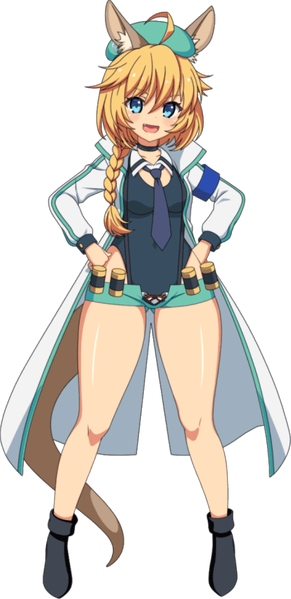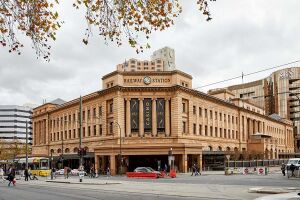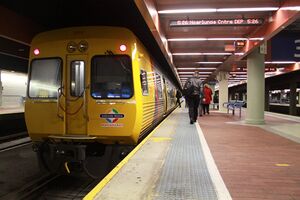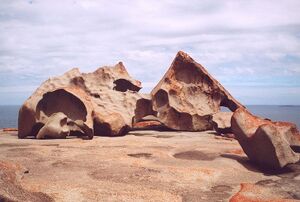
Adelaide
| Adelaide | |||||
|---|---|---|---|---|---|
| Japanese Name | アデレード | ||||
| Weapon | |||||
| Race | Beast | ||||
| Nationality | |||||
| Birthday | April 19 | ||||
| Constellation | Aries | ||||
| Talents | Kickboxing | ||||
| Likes | Sleeping bags | ||||
| Dislikes | Aristocrats and other upper class people | ||||
| Strengths | Very optimistic and forward-thinking | ||||
| Weaknesses | Unable to think flexibly | ||||
| Hobbies | Making sleeping bags | ||||
I'm Adelaide from the Flamarinian outbacks. As ya can see, I av a pair of animal ears 'n a tail. Do ya know what kind of animal it is? Aye, that one. That animal with the pouch in its belly. Bloody oath, it's a kangaroo! That's why I'm good as gold in fights! Swish-swish SWOOSH!
Layers
| Icon | Title | Release Date | Where to Obtain |
|---|---|---|---|
| [Lonely Wild Child] Adelaide | 2022 April 10 | [Training Camp - Adelaide] Event Reward | |
| [Fluffy Kangaroo] Adelaide | 2023 October 24 | [Altar of Judgement - The Snake Tree Nepenthes] Event Reward | |
| [Vibrantly Punching] Adelaide | 2022 April 1 | [Chicks and Hymn of the Cradle] Event Reward | |
| [Wild-Bred Martial Artist] Adelaide | 2022 March 31 | 1.5 Anniversary Limited Gacha 3 |
Obtained Skills
Trivia
- Adelaide's birthday is the opening date of Adelaide station in 1856.
- Adelaide's beast motif is the kangaroo. The kangaroo is Australia's national animal and is depicted on the Australian coat of arms and the Adelaide city coat of arms. Kangaroo Island lies off the mainland of South Australia, southwest of Adelaide.
- Adelaide's boxer + kangaroo theme is a direct reference to the boxing kangaroo - a national symbol of Australia, frequently seen in pop culture. The symbol is often displayed prominently by Australian spectators at sporting events, such as at cricket, tennis, basketball and football matches, and at the Commonwealth and Olympic Games.
Counterpart
Adelaide Railway Station is the central terminus of the Adelaide Metro railway system. All lines approach the station from the west, and it is a terminal station with no through lines, with most of the traffic on the metropolitan network either departing or terminating here. It has nine platforms, all using broad gauge track. It is located on the north side of North Terrace, west of Parliament House. The Adelaide Casino occupies part of the building that is no longer required for railway use. Until 1984, Adelaide station was also the terminus for regional and interstate passenger trains, but there are no longer any regular regional train services in South Australia, and all interstate services are now handled at Adelaide Parklands Terminal.
The first passenger train departed from Adelaide station on 19 April 1856, carrying the Governor of South Australia and various dignitaries to a celebratory lunch at Port Adelaide. The original Adelaide station handled all passenger, freight and livestock traffic at the North Terrace site. Livestock was unloaded adjacent to the markets and abattoirs, which were opposite the Newmarket Hotel, on the corner of West Terrace. In 1865, the station yard covered an area of 55,000 square metres (13 acres).
The period from 1922-1930 was known as the Webb era on South Australian Railways. Under the leadership of a new Railways Commissioner, William Alfred Webb, South Australian Railways began a massive rehabilitation programme. Worn-out infrastructure, under-powered steam locomotives, undersized rolling stock and outdated operating systems were all modernised and upgraded along essentially American lines. Among the many improvements that Webb championed, two of the best remembered are the introduction of new powerful steam locomotives and the rebuilding of Adelaide station.
Patronage of country rail services declined through the 1950s and 60s as car ownership became more widespread. However, much of rural South Australia still retained daily passenger trains. Many of these services were operated by air-conditioned Bluebird Railcars, which had been introduced by the South Australian Railways from 1954 onwards. On 28 February 2020, Renewal SA announced a revitalisation programme of the station building, projected to take about three years to complete. A new entrance at the northern end would be created, featuring vaulted ceilings, and a public artwork by installation artist James Geurts. In addition to enhancing the architectural features of the building, and upgrading the North Terrace frontage, an expansion of food and retail tenancies, along with cultural experiences, would create a hub for people to meet and spend time there, changing the social atmosphere. Wikipedia
Kangaroo Island, also known as Karta Pintingga (literally 'Island of the Dead' in the language of the Kaurna people), is Australia's third-largest island, after Tasmania and Melville Island. It lies in the state of South Australia, 112 km (70 mi) southwest of Adelaide. Its closest point to the mainland is Snapper Point in Backstairs Passage, which is 13.5 km (8.4 mi) from the Fleurieu Peninsula.
Flinders Chase National Park (formerly Flinders Chase) is a protected area in the Australian state of South Australia located at the west end of Kangaroo Island about 177 kilometres (110 miles) west-south west of the state capital of Adelaide and 110 kilometres (68 miles) west of the municipal seat of Kingscote. It is a sanctuary for endangered species and home to a few geological phenomena. It was the second national park to be declared in South Australia.
Flinders Chase National Park consists of three sections - an area of coastal landscapes around Cape du Couedic in the south west corner of the island, the Gosse Lands in the centre of the west end of the island and the former Cape Borda Lightstation reserve in the north west corner of the island. The national park contains two geological features that have been listed as geological monuments by the Geological Society of Australia - Cape du Couedic and Remarkable Rocks. Remarkable Rocks are naturally sculptured formations precariously balanced atop a granite outcrop. They remind visitors of the sculptures of Henry Moore. Wikipedia
Map
Gallery
- Pages using Tabber parser tag
- Pages using DynamicPageList3 parser tag
- Weapon Gauntlet
- Beast
- Flamarine
- Aries
- Element Blow
- Element Dark
- Element Fire
- Element Wind
- Element Water
- Metro Train Knights
- Australia













